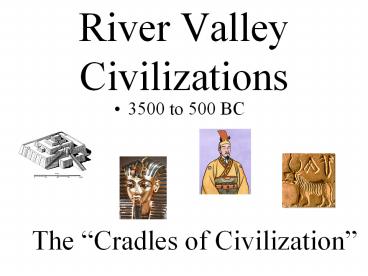River%20Valley%20Civilizations PowerPoint PPT Presentation
Title: River%20Valley%20Civilizations
1
River Valley Civilizations
- 3500 to 500 BC
The Cradles of Civilization
2
Where did the earliest civilizations develop?
- River valleys
3
Why did ancient civilizations develop in river
valleys?
- They had rich soil for agriculture because
periodic flooding left silt which made the soil
rich in nutrients
4
They were protected by geographic barriers
(mountains, deserts, seas, jungles, etc.)
5
Where were the earliest civilizations located and
when did they exist?
C
M
I
E
6
River Valley Civilizations
(3500 BC to 500 BC)
- Mesopotamia in Southwest Asia
- Egypt in Northeast Africa
- India in South Asia
- China in East Asia
- From west to east EMIC
7
Evidence of Early Civilizations
8
- What were some characteristics of the Ancient
River Valley civilizations?
9
Mesopotamia SumerGeography
Mesopotamia
- Mesopotamia was a region located in the part of
the Fertile Crescent that lies between the
Tigris and Euphrates Rivers.
10
Mesopotamia
- Present-day Iraq (Middle East).
11
- Protected on three sides by mountains, deserts
and the Persian Gulf (but vulnerable to invaders
from the north)
12
Sumerian Government
- Sumer was the first known civilization
- It arose in southern Mesopotamia
13
Sumer
- Sumer was made up of 12 independent city- states
each ruled by its own king. - City-state A city and the surrounding land
14
Cuneiform
- the first written language (wedge writing)
15
Irrigation
- brought water from the rivers to the fields
during the dry summer months
16
Controlling the Rivers
17
Bronze
- Smelted from copper and tin
18
Other Sumerian Accomplishments
- Plow
- Ziggurats
- Wheeled vehicles
- Number system based on 60
19
Sumerian Inventions
20
Babylonian Empire
- The first empire to arise in Mesopotamia
- Empire several peoples, nations, or previously
independent states under the control of one ruler.
21
Code of Hammurabi
- First set of published laws
- Based on the principle of an eye for an eye
- Laws differed based on class
22
Sumer
23
EgyptGeography
- Nile Delta and Nile River Valley (Northeast
Africa)
24
Nile Delta
- The delta was located in Lower Egypt (northern
Egypt - lower in elevation) - Delta broad, marshy, triangular area of land
formed by deposits of silt at the mouth of a
river.
25
- Protected by deserts and seas
View from space shuttle
26
Egyptian Government
- Pharoahs were rulers thought to be gods. They
had absolute power (complete control) over the
Egyptian Empire. - They were thought to be responsible for making
the sun rise, the Nile flood, and crops grow.
27
- Egypt, had a rigid class system and slavery was
accepted.
28
Egyptian Religion
- Like other River Valley peoples, Egyptians were
polytheistic (believed in many gods).
29
Egyptian Writing
- Hieroglyphics Pictures stood for sounds as well
as ideas
30
Egypt
31
India Indus Valley Civilization
32
Geography
- Located on the Indus River in present-day
Pakistan (Indian subcontinent).
33
Indus River Flood Plain
34
Natural Barriers
- The Himalayan and the Hindu Kush Mountains as
well as the Indian Ocean protected the Indian
subcontinent from invasion.
35
Indus Valley Government
- Made up of independent city-states including
Harappa, and Mohenjo-Daro (and 2500 other sites)
36
Indus Valley Achievements
- Plumbing
The great bath at Mohenjo-Daro
37
Cotton Cloth
- first to cultivate cotton and weave its fibers
into cloth (textiles)
38
Writing
- has not been deciphered
39
Indus Valley
40
ChinaGeography
- Huang He River
41
- Also called the Yellow River and the River of
Sorrows (yellow silt caused flooding)
42
Flooding of the Huang He
- Satellite images
before
after
43
- Protected by the Gobi desert, Himalayan
Mountains, Pacific Ocean, dense jungles
44
Chinese Government
- China was ruled by a succession of ruling
families called dynasties (Early dynasties
Shang and Zhou)
45
China
46
- Chinese rulers were considered divine (god-like).
47
- They served under a mandate of heaven (approval
of the gods) only as long as their rule was just
48
Dynastic Cycle
- Explains the rise and fall of families of rulers
49
Ancestor Worship
- The Chinese believed that the spirits of family
ancestors could bring good fortune or disaster - They paid respect to family ancestors and made
sacrifices in their honor
50
Early Chinese Achievements
- Silk cloth (made from the cocoons of silkworms).
51
Writing
- Characters stood for ideas, not sounds.
- The earliest evidence of Chinese writing is found
on oracle bones.
52
Irrigation
- Water wheels were used to bring river water to
the fields
53
- Bronze
Bronze vessel used for sacrificial food
54
Shang Dynasty

